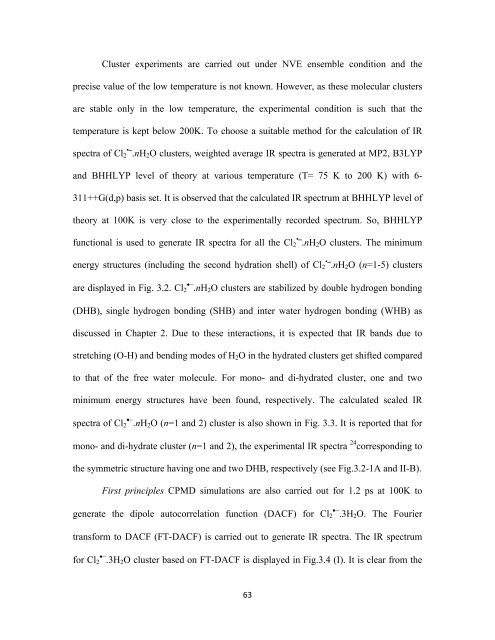CHEM01200604005 A. K. Pathak - Homi Bhabha National Institute
CHEM01200604005 A. K. Pathak - Homi Bhabha National Institute
CHEM01200604005 A. K. Pathak - Homi Bhabha National Institute
Create successful ePaper yourself
Turn your PDF publications into a flip-book with our unique Google optimized e-Paper software.
Cluster experiments are carried out under NVE ensemble condition and the<br />
precise value of the low temperature is not known. However, as these molecular clusters<br />
are stable only in the low temperature, the experimental condition is such that the<br />
temperature is kept below 200K. To choose a suitable method for the calculation of IR<br />
spectra of Cl • 2 ⎯.nH 2 O clusters, weighted average IR spectra is generated at MP2, B3LYP<br />
and BHHLYP level of theory at various temperature (T= 75 K to 200 K) with 6-<br />
311++G(d,p) basis set. It is observed that the calculated IR spectrum at BHHLYP level of<br />
theory at 100K is very close to the experimentally recorded spectrum. So, BHHLYP<br />
functional is used to generate IR spectra for all the Cl • 2 ⎯.nH 2 O clusters. The minimum<br />
energy structures (including the second hydration shell) of Cl • 2 ⎯.nH 2 O (n=1-5) clusters<br />
are displayed in Fig. 3.2. Cl •− 2 .nH 2 O clusters are stabilized by double hydrogen bonding<br />
(DHB), single hydrogen bonding (SHB) and inter water hydrogen bonding (WHB) as<br />
discussed in Chapter 2. Due to these interactions, it is expected that IR bands due to<br />
stretching (O-H) and bending modes of H 2 O in the hydrated clusters get shifted compared<br />
to that of the free water molecule. For mono- and di-hydrated cluster, one and two<br />
minimum energy structures have been found, respectively. The calculated scaled IR<br />
spectra of Cl •− 2 .nH 2 O (n=1 and 2) cluster is also shown in Fig. 3.3. It is reported that for<br />
mono- and di-hydrate cluster (n=1 and 2), the experimental IR spectra 24 corresponding to<br />
the symmetric structure having one and two DHB, respectively (see Fig.3.2-1A and II-B).<br />
First principles CPMD simulations are also carried out for 1.2 ps at 100K to<br />
generate the dipole autocorrelation function (DACF) for Cl •− 2 .3H 2 O. The Fourier<br />
transform to DACF (FT-DACF) is carried out to generate IR spectra. The IR spectrum<br />
for Cl •− 2 .3H 2 O cluster based on FT-DACF is displayed in Fig.3.4 (I). It is clear from the<br />
63
















